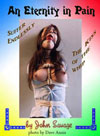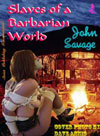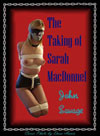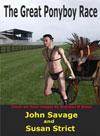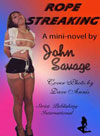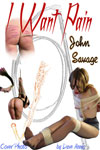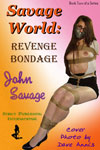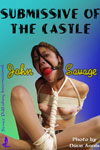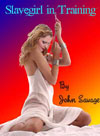






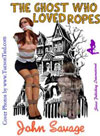

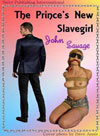
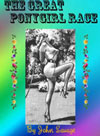
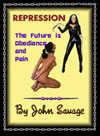

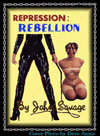

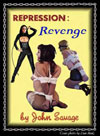

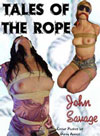
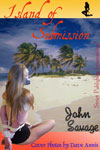

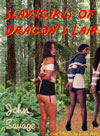
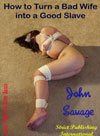
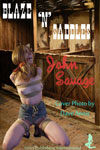

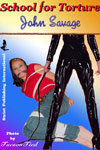
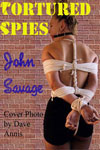

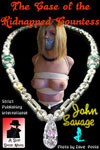
So
You Want to Write BDSM?
By
John Savage
People
who engage in the Kinky Arts are, generally speaking, more intelligent
than average. It is not
surprising, then, that they are also often more creative than most and
also often want to express this via the written word.
For those of you who are dying to become published kinky authors, I
offer a few words of advice.
Why
me? There are a lot of books
around about how to write. I
have a whole shelf of them in my office.
Some are very good; some I have to wonder how they ever got
published. But among all
those books, I have not seen one that purports to explain how to write
good BDSM. (I assume you know
that BDSM stands for Bondage, Discipline, Sadism and Masochism, with the
middle DS also standing for Domination/submission.) I have “been there, done that,” as the saying goes.
As of this writing, I have published over fifty novels, the vast
majority in the field of BDSM but a few in other areas.
I’ve made most of the typical mistakes of beginning authors and
learned from them. Let me pass some words of wisdom on to help you avoid those
mistakes.
I’ll
cover three main areas: Subject Matter, Writing, Submission.
Subject Matter
An
important point to keep in mind is that not all kinks are popular.
Your enjoyable, fun, and stimulating kink may not be shared by many
others.
Bondage,
S&M, lesbian sex, and gay literature all sell. They are of interest to enough of the public so that a
constant stream of new material, be it written word or stills or video, is
in demand. However, golden
showers, diaper play, lactating females, and such, appeal only to much
smaller groups of people. If
smearing olive oil all over a naked woman and licking it off while wearing
swim fins and humming Italian opera is your thing, be aware that not many
other people will want to read your writing.
Which means that some subject matter simply does not sell.
And
don’t forget that some subject matter is illegal, or at least in
terribly bad taste. Underage
sexual activity is illegal. Animals
involved in sexual acts may not always be illegal, but why take a chance?
The same logic applies to scat, breaking bones, necrophilia and
other unpleasantness. If you
wish to write about them, be aware that you’re targeting a much smaller
market and might be antagonizing the distributors upon whom you depend.
By that, I mean it should be noted that while some text may not be
illegal, many of the acts I mentioned above will get your writing kicked
off distributors’ websites. More
about this later.
While
talking about subject matter, there is a saying in the writing field that
is very true: “write about what you know.”
Nothing turns off a reader faster than a writer making mistakes
about facts or obviously diving into waters he does not know.
If you don’t know the first thing about the practical aspects of
suspension bondage, it will show in your writing. Likewise, if you really understand and are well versed in a
subject, that will also show
Concerning
the field of BDSM itself, there are a few books out about it, but not
many. If you wish to know
more, exploring the Internet is the best way.
Attending local educational/party groups is also good.
Here in the San Diego area there is a group called Club X.
You can learn a lot from them, plus meet some interesting people.
On the Internet, there are numerous websites offering all kinds of
kinky material. Those sites,
especially those that sell books and stories, will tell you a lot about
what readers want and are buying. There
are also “social” websites that allow people to get in contact with
others who share the same kinky interests.
Some of the more well known are www.collarme.com,
www.fetlife.com,
and www.alt.com. These have
discussion forums and are a good source of learning, but beware – there
are a great many fakes out there, especially “women” who are really
men playing mind games.
Writing
Getting
down to the nuts and bolts, writing good BDSM is no different from writing
good literature of any type. You
want to get your ideas across to the reader in a clear, logical, easy to
read style that also entertains. This
means that the writing must adhere to the rules of proper grammar,
spelling, etc. Contorted
sentences, poor punctuation, misspellings, and using the wrong word will
turn a reader off. The
writing should be transparent. By
that, I mean it should not get in the way of the thought getting across to
the reader. If you are
describing a scene, you want the reader to envision the scene, not be
aware of your writing style, or lack of it.
If
you have read a book by an author who does not think the rules of grammar
are for him, you will know what I mean.
So pay attention to those rules.
You don’t have to be a perfect grammarian, but you should know
the basics. And be willing to
constantly learn, especially from your mistakes.
One of the best ways to learn and assure your text is acceptable is
to use an editor, someone other than yourself who hopefully knows more
about the language than you do. More
about this later.
The
spelling checker in your word processor is your best friend. Always use it! Nothing
turns off a publisher faster than misspelled words. Or misused words. Make
sure that you understand the meaning of a word before you use it.
Do you know the difference between “discreet” and
“discrete”? Many word
processors have built-in dictionaries now.
Use that if there is any doubt about the meaning.
I also keep Webster’s Seventh New Collegiate Dictionary next to
my desk and have for more years than I care to remember.
Having a good thesaurus is a valuable tool to find the right word.
When
I write a novel, I do several things to help myself.
First, I make a list of each character as the person is introduced.
This list helps me remember names, ages, hair color, and other
facts about these people I am creating.
It is not a bad idea to write a little biography about each major
character. Nothing fancy,
just a little background to help “flesh them out.”
The reader doesn’t necessarily have to be told all of it, but
unless you can “feel” your characters then it’s unlikely you can
make them real to the readers. I
have gone so far as to wander around the Internet, looking at photos of
people. When I find a photo
of a person who looks like the one I’m trying to describe, I save it
with my list of characters. This
helps me to make this character a believable person.
A
bit of digression here. One
of the books on my bookshelf is “Fiction is Folks” by Newton Peck. In it, he emphasizes that the vast majority of writing is
about people: what they are, what they do, and even why they do it.
Good writing always creates believable characters.
That way, the readers can imagine them as real people and even
associate with them. Creating
the believable character in your mind helps you put down the right words
to create him or her in the reader’s mind.
This
is a simple idea but an important point in writing fiction.
If you create believable characters in your mind, you can almost
simply put them down in a situation and then stand back and watch what
they do. Sometimes novels
almost write themselves that way. Oh,
I know it’s really coming from my subconscious, but at times it seems
that my fingers are doing the writing and I’m just watching the screen
to see what happens next.
Back
to how to write.
A
couple more points that apply to all writing.
You want your writing to be alive.
You want it to almost jump off the page and grab the reader’s
attention. Make it lively and
colorful. Don’t engage in
long narratives about someone’s past.
Show them doing something and make it exciting.
Without being wordy, describe the settings well enough so that
someone can imagine what the place looks like, just as you do in your
mind.
Show,
don’t tell. Describing an
action in lively words is always better than simply stating that it
happened. “He stabbed
Wilbur,” is not as good as “With anger flaring in his eyes, he plunged
the dagger into the heart of the villain Wilbur and delighted in seeing
his life-blood gushing out.” A
bit gruesome, but I think you understand what I’m saying.
Another
point: The Hook. I took a
UCLA Extension writing class one time from a professional author.
In one of the first sessions, he told us to try to get the
reader’s attention immediately. He
read us the first line of a book, the title of which I do not remember,
but it went: “He had not been in town but two days when he knew they
meant to kill him.” Now
doesn’t that make you want to read the next sentence?
It gets your attention.
I
call this “The Hook.” It
catches the reader’s attention and makes them want to read more.
I try to do this in the first sentence of any book I write.
If you don’t hook the reader into your book, you run the chance
of losing him or her. If you
have ever read a book that lacks a hook, you can probably see what I mean.
You’ve
all read the vivid description of a book’s contents they put on the back
cover in just inside the cover. We
call that the “blurb.” It
is just another form of The Hook. In
a few sentences, the blurb tries to catch your interest and make you buy
the book.
A
quick note about pace. No one
likes to read a book that becomes boring and dull.
Keep the pace quick enough so the reader cannot get bored. And that means action. Make
things happen at a good clip. If
a little background is needed to understand a character’s motivation,
fine. But don’t devote more
than is necessary. No
chapter-long descriptions of how his mother trained him to eat every
particle of food on his plate and that’s why he’s fat today and a
compulsive overeater.
Okay,
let’s say that you’ve come to the end of your tome and the hero has
got the girl (probably tied down to his bed and moaning with desire).
That’s the end, right? Maybe.
Have you tied up all the loose ends?
(Yes, I know that’s a bondage pun.)
Did you leave his former sweetheart still tied to the railroad
tracks with the 3:10 to Yuma coming?
Are all the mysteries solved?
Don’t leave the reader wondering what happen to someone or why
something happened the way it did. You
owe it to the reader to finish the story for him.
It’s the honest way.
The
exception to this is, of course, if you plan a sequel.
It seems popular these days to write books in at least trilogies.
I have one sequence that runs four books following the same
heroine. If that is what you
plan, you can leave Mary Lou tied to the railroad tracks because that will
become the start of the next book.
Here’s
something you may not have thought about.
Every good book has a conflict.
Without exception. Conflict
creates drama, and drama makes the book worth reading.
The conflict maybe man against man, man against nature, whatever.
But there has to be some problem, some task to perform, some
mystery to solve, some obstacle to overcome.
Believe me, a book in which no one has any problems and everything
is just fine is a boring book.
Oh,
and occasionally let the villain win.
It has always bugged me the way novels, movies and TV shows in our
society always end up with the good guys wining, all the villains defeated
and everyone living happily ever after.
Real life ain’t like that.
Well,
one of the nice things about writing is that you create what you want.
You can create entire worlds and societies, alternate histories and
places were magic works. That’s part of the fun of writing. So long as the reader is entertained, you can manipulate
people, nature and the fates. So
if you want the villain to win one now and then, let it be so!
Along
with pace and believable characters, have a real plot.
If you establish a real conflict immediately, the plot will follow
as the conflict resolves. A
book that is nothing but a series of descriptions, no matter how nice they
are, is boring. Make people
try to accomplish things. Give
them obstacles to overcome. Give
them setbacks and problems to solve.
Please try to make your book more than a series of descriptions of
your favorite sex act.
Target
your audience. Know the type
of people you are writing for. Your
writing level and vocabulary should match your audience.
I have written juveniles for the ten to fourteen year old group and
make every effort to write in a language and level they are used to.
Study your potential audience.
Study the books that are currently offered to them, especially
those that sell well. Understand
your audience, what they want, and what words will convey that to them
best.
I
have often said that a good writer is a good reader.
No one is born a brilliant writer.
Everyone has to learn the craft.
And the best way I know to do that is to read a great deal, and
then practice writing. You
want to have a good feel for the type of books being sold in the field you
want to enter, but reading all kinds of books will help you.
If you liked a particular book, ask yourself why?
Was it his writing style, his characters or the way he describes
action? If you can copy his
style (without actually stealing his words), go ahead.
It happens all the time. I
do it all the time. And it is
the best way for a beginner to develop a successful, sellable style.
You’ve
probably heard the term “Writer’s Block.”
That’s not the street where all the writers live, it means that
suddenly you just can’t get your fingers to punch the keys and words to
flow. Everyone gets this now
and then, but it is really over estimated.
First you have to remember an old saying in the writing field:
“Writing is 10 percent inspiration and 90 percent perspiration.”
This means that writing is WORK.
You have to have discipline and determination to create something
that will entertain people, and perhaps make you a little money besides.
Two
points about Writer’s Block. First,
you need to be consistent about your writing.
I don’t mean that you have to write every day, but that is good
if you can. What I mean
is that you sit yourself down before the word processor and you write.
Don’t look at the computer and declare that you don’t feel like
writing today. Sit down and
write something. I have found
that once I get the first sentence started, the second one is easier and
soon I’m pounding away on the keyboard.
(I go through a couple keyboards a year.)
The
second point is that if you are suffering from Writer’s Block, there is
a chance it is because you have written yourself into a corner. Your plot has come to a dead end and there is no way to
proceed. Maybe you’ve
created an impossible situation or maybe you’ve run out of ideas.
Try to recognize if your plot is on its last legs.
Maybe you’ll have to back up and take it in another direction.
There may even be times when you will have to scrap a chunk of text
and rewrite. That’s okay;
all writers have to do it occasionally.
A
hint. If you have trouble
starting a book or don’t know what to write about, in your mind create a
couple of people and then dump them into a situation that will force them
to have to do something. Cynthia
Snodgrass and her boyfriend Reggie Von Glesson suddenly find themselves
surrounded by horny biker dykes. What
happens next? Let your imagination go to work.
A
couple more points about writing and we’ll go on.
First, when you finish a work, be it a large novel or just a short
story, put it aside. After a
few days, come back to it to do your proof reading.
The proof reading is important so that you will be offering a
better work to the publisher. You’ll
find that you’ve made typos and other mistakes.
Everyone does. The
idea is to catch them before your publisher does.
That’s why you should put the work aside for at least a few days.
If you do a proof reading immediately after finishing the work,
your mind will see on the screen/page what it thinks you wrote.
After a while has passed, your mind will be more likely to see what
is really there. I know you’re anxious to get your Great American Novel off
to the publisher, but take the time to make it as error-free as you can.
If
you should be so lucky and/or skillful as to get a novel or two published,
be aware of another trap. Don’t
get into a rut! It is too
easy to keep writing the same novel over and over, changing only the
character’s names and locations. When
you are going to start a new novel, ask yourself if this is different from
those you’ve written before. If
it isn’t, you’re taking a chance on a publisher turning it down or,
worse, your readers becoming bored. New
ideas and fresh approaches are not always easy but they make for a much
better writer.
SUBMISSION
Before
you put the first words down, you should be aware of the proper format of
a book. There are certain
rules that make it easier on the publisher and are more likely to get your
work published. Every
publisher has different guidelines for the works submitted to them.
You can usually obtain them from the publisher simply be requesting
them. Follow their rules.
Generally speaking, he will want you to use a certain font, size
and page formatting. On the
first page, always include your name and address along with the title.
If you wish to use a pseudonym, make it clear by putting it below
the title. The title should
be in larger font size. Some publishers want the number of words printed on the first
page.
Make
sure that the file you send him is in the correct computer format.
Microsoft Word format is universal (more or less).
But there are different versions.
Generally speaking, the .DOC or .DOCX format is preferred.
For
purposes of this discussion, I am assuming that you wish to write for the
ebook market. There are
several reasons for doing that, the biggest one being that you are much,
much more likely to get published. Believe
me, the traditional hardbound or paperback book market is very hard to
break into. Even if you have
a good manuscript, it’s still hard.
I had some of my novels published in paperback and what is called
“trade publications,” which mean a larger, slicker paperback format.
But I no longer try that market and concentrate only on ebooks.
Besides, the ebook market is taking off like a rocket.
With the new Kindles and competitors, plus tablet computers that
can be used as book readers, there is a real, growing market place for
your work.
Allow
me to tell you some of the facts of life about the e-publishing world.
First
off, there are numerous ebook formats, usually identified by the suffix on
the file name. There are .MOBI,
.LIT, .EPUB, .PDF and others. Secondly,
there are only a limited number of places where ebooks can be sold, almost
exclusively websites. There
are a lot of small websites selling ebooks, but the big players are
Amazon, Barnes and Noble, and Apple.
If
you wish to, you can attempt to publish your ebook yourself. But then you have to worry about the various formats, and
getting your item to the distributors.
You would have to be aware of the major formats and be able to
convert your ebook into each. You
would have to be familiar with the distributor websites and deal with each
one yourself. And you have to
worry about being rejected due to subject matter, cover, or other reasons. Believe me, some of the distributors can be extremely anally
retentive about sexual ebooks.
All
of this leads to a fact: a good publisher is your friend.
He
(or she) will worry about formats, distribution and other problems.
Also worry about getting you an ISBN, which is required by many
distributors. And other
factors us creative people hate to have to deal with.
But perhaps the biggest reason to deal through a publisher rather
than do it all by yourself is that a good publisher is also a good editor.
He or she will read your book, correct grammar as needed, make
suggestions about content and try his/her hardest to make your work
marketable.
In
the past I have dealt with four different publishers and had problems with
most, including one who stopped paying me royalties but continued to sell
my books. Now I deal with
only one and am happy with this arrangement.
Sure, a publisher takes a percentage of the profit, but I think it
is well worth it for the service given to the writer.
A
few more words about the package that you put together and submit to your
publisher. First off, it
helps tremendously if you include a blurb.
This is a short description of the novel, only a paragraph or two. But it serves to identify the subject matter and will
interest the potential reader and make him want to put out the money to
buy your work. It is much
easier for you, the author, to write the blurb than leaving that to the
publisher. You know the book
better and are a creative writer. Make
it sound as if this is the greatest BDSM/adult novel ever.
It is filled with action, colorful characters, and the most kinky
sex since Adam discovered Eve liked to be tied to the apple tree.
A
quick word about covers. Ebooks,
like their paperback cousins, have a cover.
And, as with paperbacks in the bookstore, you want the cover to
sell the book. You want it to
reach out and grab the reader’s eye, make him want to learn more and
eventually buy it. I do my
own covers, which you can see on my website.
Generally I do two covers, one with breasts showing for adult
websites, and one milder one for the more general sites.
If you are good with graphic software and want to try making your
own covers, great! If done
effectively, it will make your package more attractive to a publisher and
prospective buyers. If you
lack the skill and/or software, don’t despair.
Your publisher can usually whip up something for you.
(Another B&D pun).
And,
you ask after all this, how long should I make my book? How many words does it take to make an ebook novel?
As
a general rule, I try to make my novels about 35,000 words or longer.
Some of my works have gone as high as 60,000 words but the 35,000
figure works well for the adult ebook field.
A good book that is shorter may still sell, but usually at a lower
price. The smallest book I
have out is “Rope Streaking.” It
is only 10,000 words and is an experiment to see if a mini-novel will sell
at a reduced price. Do not,
however, compromise good writing to fit a certain word count.
Write the story as well as you can and don’t worry about the
length.
In
case you’re not familiar with word counts, 35,000 words is the
equivalent of 140 double spaced typed pages.
Your word processor should have a word counter built into it.
Which
brings us to the subject of monetary rewards.
How much will you make from having your ebook or ebooks sold on
websites? That will depend,
logically, on how well it sells. But
don’t expect to become a millionaire.
The author normally will get about fifty percent of the selling
price of the book. With an
average price of around five dollars per book, you can see that it will
take a fair amount of sales before you are making much money.
I’ll be honest and say that you won’t get rich writing adult
ebooks. I don’t get a lot, but it helps feed my Viper (the car, not
the snake). Perhaps it would
be best if you were to be content with some money and the pride of knowing
you’re a published author. (I
brag a lot.)
Of
course, if your books sell well, and you get a fair number of them out on
the websites, you will make more money.
The nice thing is that an ebook will continue to sell theoretically
forever. Or as long as the
Internet lasts. There is no
limit to the amount of ebooks that can be sold.
There is no fixed number of copies printed and then no more.
Your great grandchildren may be still getting royalties fifty years
from now.
WRAP-UP
I’ve
tried to give you some helpful hints and perhaps answer some questions you
may have about writing adult BDSM novels.
This has been a quick summary of some points.
If you are serious about becoming a good writer, there are books at
the public library about writing. There
may even be a club for aspiring writers in your area. And there are reasonably priced classes at the local
community colleges.
I
know that I discussed bondage and sadistic acts and sex very little.
I’ll leave that up to you. A
final word of advice is to study the marketplace.
See what’s out there. Can
you do that kind of work? Or
maybe better?
I
wish you the best of luck.
John
Savage

